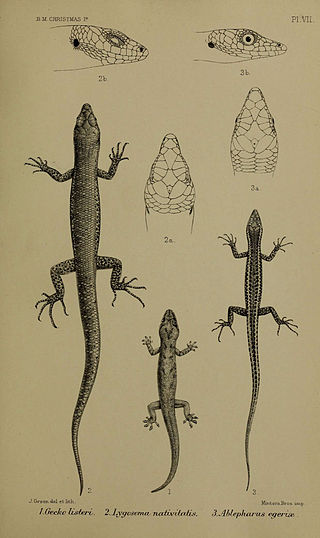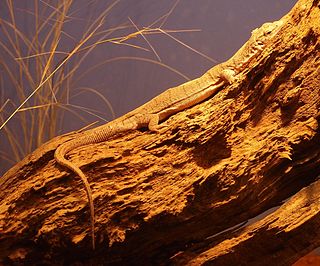
Lizards are a widespread group of squamate reptiles, with over 7,000 species, ranging across all continents except Antarctica, as well as most oceanic island chains. The group is paraphyletic since it excludes the snakes and Amphisbaenia although some lizards are more closely related to these two excluded groups than they are to other lizards. Lizards range in size from chameleons and geckos a few centimeters long to the 3-meter-long Komodo dragon.

Gekkonidae is the largest family of geckos, containing over 950 described species in 64 genera. Members of the Gekkonidae comprise many of the most widespread gecko species, including house geckos (Hemidactylus), tokay geckos (Gekko), day geckos (Phelsuma), mourning geckos (Lepidodactylus) and dtellas (Gehyra). Gekkonid geckos occur globally and are particularly species-rich in tropical areas.

Underwoodisaurus is a small genus of Australian lizards in the family Carphodactylidae. Member species are commonly known as thick-tailed geckos, along with the species Uvidicolus sphyrurus.

Darevskia is a genus of wall lizards of the family Lacertidae. Member species are native to the Caucasus, Iran and Turkey, living in forest and grassy habitats with numerous rock outcrops. Among rock lizards, seven parthenogenetic species are known.

The New Mexico whiptail is a female-only species of lizard found in the southwestern United States in New Mexico and Arizona, and in northern Mexico in Chihuahua. It is the official state reptile of New Mexico. It is one of many lizard species known to be parthenogenetic. Individuals of the species can be created either through the hybridization of the little striped whiptail and the western whiptail, or through the parthenogenetic reproduction of an adult New Mexico whiptail.

The common house gecko is a gecko native to South and Southeast Asia. It is also known as the Asian house gecko, Pacific house gecko, wall gecko, house lizard, tayoto, chipkali or moon lizard.

Parthenogenesis is a natural form of asexual reproduction in which growth and development of embryos occur in a gamete without combining with another gamete. In animals, parthenogenesis means development of an embryo from an unfertilized egg cell. In plants, parthenogenesis is a component process of apomixis. In algae, parthenogenesis can mean the development of an embryo from either an individual sperm or an individual egg.

Lepidodactylus listeri, also known commonly as Lister's gecko or the Christmas Island chained gecko, is a species of gecko, a lizard in the family Gekkonidae, endemic to Christmas Island in the Indian Ocean. It is currently extinct in the wild.

Menetia greyii, commonly known as the common dwarf skink or Grey's skink, is a species of lizard in the family Scincidae. The species is endemic to mainland Australia and Indonesia.

Lepidodactylus lugubris, known as the mourning gecko or common smooth-scaled gecko, is a species of lizard, a gecko of the family Gekkonidae.
Christinus alexanderi, also known as Alexander's southern gecko or Alexander's marbled gecko, is a species of Gekkonidae geckos found in the Nullarbor Plain of Australia. It is one of the many species and subspecies regionally termed as marbled geckos.

Gehyra variegata, the tree dtella, variegated dtella or varied dtella, is a species of gecko in the genus Gehyra, native to inland Australia.

The pygmy mulga monitor, also known as Gillen's monitor or just mulga monitor is a species of lizard in the family Varanidae.

Lucasium steindachneri, commonly called the box-patterned gecko or Steindachner's gecko, is a species of nocturnal, medium-sized lizard in the family Diplodactylidae. The species has a pale strip with three patches of brown along its back. This gecko is terrestrial and only found in arid and semi-arid areas of continental Australia.
Parthenogenesis is a mode of asexual reproduction in which offspring are produced by females without the genetic contribution of a male. Among all the sexual vertebrates, the only examples of true parthenogenesis, in which all-female populations reproduce without the involvement of males, are found in squamate reptiles. There are about 50 species of lizard and 1 species of snake that reproduce solely through parthenogenesis. It is unknown how many sexually reproducing species are also capable of parthenogenesis in the absence of males, but recent research has revealed that this ability is widespread among squamates.
Lucasium byrnei, also known commonly as the gibber gecko, Byrne's gecko, and the pink-blotched gecko, is a species of small, nocturnal lizard in the family Diplodactylidae. The species is endemic to Australia.

Wahlberg's velvet gecko is a species of large gecko, a lizard in the family Gekkonidae. The species occurs exclusively in Southern Africa.

Nephrurus levis, commonly known as the three-lined knob-tailed gecko, smooth knob-tailed gecko, or common knob-tailed gecko, is a native Australian gecko species. The smooth knob-tailed gecko is part of the Carphodactylidae family, a family endemic to Australia. A common, alternative, name for this family is barking geckos due loud barks they make during threat displays, which includes swaying their bodies, winding their tail and attacking with an open mouth. There are multiple sub-species of Nephrurus levis, these include N.l. levis, N.l. occidentalis and N.l. pibarenis. Its aboriginal name is Illchiljera.

The variable fat-tailed gecko or burrow-plug gecko is a diplodactylid gecko endemic to central and arid inland areas of Australia. Widespread across the continent, the variable fat-tailed is most commonly found in sandy desert habitats dominated by Spinifex grasses. They have also been bred in captivity by zoos and as pets.

Strophurus williamsi, also known commonly as the eastern spiny-tailed gecko, the soft-spined gecko, and Williams' spiny-tailed gecko, is a species of lizard in the family Diplodactylidae. The species is endemic to semi-arid regions of eastern Australia including Queensland, New South Wales, Victoria and South Australia. It has become a popular species as a pet for its distinctive tail features. S. williamsi has been grouped within a clade of seven other species that are believed to have diverged from their ancestors around 20 million years ago. S. williamsi can be distinguished from closer relatives by arboreality and diurnal (day-active) activity.


















